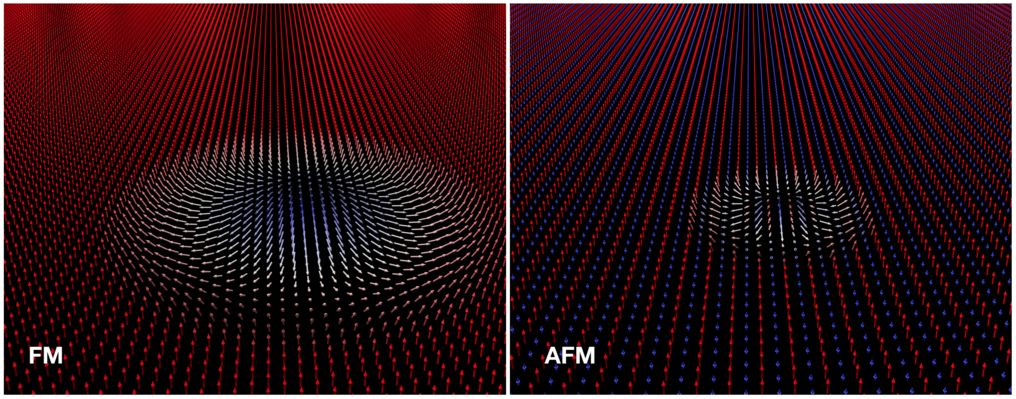For physicists, magnetism is intimately coupled to rotating motion of electrons in atoms. Orbiting around the atomic nucleus as well as around their own axis, electrons generate the magnetic moment of the atom. The magnetic stray field associated with that magnetic moment is the property we know from e.g. a bar magnet we use to fix notes on pinboard. It is also the magnetic stray field that is used to read the information from a magnetic hard disk drive. In today's hard disks, a single magnetic bit has a size of about 15 x 45 nanometer, about 1.000.000.000.000 of those would fit on a stamp.
One vision for a novel concept to store data magnetically is to send the magnetic bits back and forth in a memory chip via current pulses, in order to store them at a suitable place in the chip and retrieve them later. Here, the magnetic stray field is a bit of a curse, as it prevents that the bits can be made smaller for even denser packing of the information. On the other hand, the magnetic moment underlying the stray field is required to be able to move the structures around.
The researchers were now able to put an "invisibility cloak" on the magnetic nanostructures and to observe, how small and how fast such structures can get. To this end, different atomic elements with opposite rotation of the electrons were combined in one material. In this way, the magnetic stray field can be reduced or even completely cancelled - the individual atoms, however, still carry a magnetic moment but together appear cloaked.
In spite of this cloaking, the scientists were able to image the tiny structures. Via x-ray holography, they were able to selectively make only the magnetic moments of one of the constituent elements visible - in this way an image can be recorded in spite of the invisibility cloak.
It became apparent, that fine tuning of the strength of the invisibility cloak allows to simultaneously meet two goals which are of importance for potential applications in data storage. "In our images, we see very small, disk-like magnetic structures", says Dr. Bastian Pfau from MBI. "The smallest structures we observed had a diameter of only 10 nanometer". The information density of today's hard disk drives could be significantly increased, if such structures could be used to encode the data. Furthermore, in additional measurements the researchers realized that suitably cloaked bits can be moved particularly fast by short current pulses - an important property for actual use in a memory device. A velocity higher than 1 kilometer per second was reached in the MIT laboratory.
"This is possible as a consequence of quantum physics", explains Prof. Stefan Eisebitt from MBI. "The contribution of the electron's orbit around the nucleus to the magnetic moment is only half as large as the contribution of the electron's spin around its own axis." When combining different atom types with different direction and strength of this rotation in one material, one can cancel the total rotation - physicists talk about the total angular momentum - of the system, while still retaining a small magnetic moment. As the angular momentum leads to a drag when moving the structures via current pulses, this approach allows for high speed motion. Hence, if the strength of the invisibility cloak is adjusted just right, both small size and high speed of the magnetic bit structures can be achieved - an interesting prospect for novel magnetic data storage concepts.
